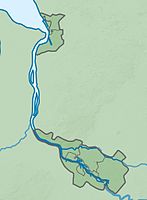Eispohl, sand drifts and heather ponds
|
Eispohl, sand drifts and heather ponds
|
||
|
Dune with heather plants |
||
| location | Bremen , Free Hanseatic City of Bremen | |
| surface | 35.5 ha | |
| Identifier | 8th | |
| WDPA ID | 162904 | |
| FFH area | 23 hectares | |
| Geographical location | 53 ° 12 ' N , 8 ° 33' E | |
|
|
||
| Sea level | from 21 m to 30 m | |
| Setup date | July 1, 1988 | |
Eispohl, Sandwehen and Heideweiher is the name of a nature reserve in the districts of Lüssum-Bockhorn and Farge in the Blumenthal district of the municipality of Bremen .
General
The nature reserve designated on July 1, 1988 as "Eispohl / Sandwehen" was initially 12.5 hectares in size. On March 25, 2014 it was expanded to form the approximately 35.4 hectare nature reserve "Eispohl, Sandwehen and Heideweiher". Areas previously under landscape protection were included in the nature reserve. The 23 hectare FFH area "Heide und Heideweiher auf der Rekumer Geest", designated in 2004 , lies entirely within the scope of the Nature Conservation Ordinance. The nature reserve is entered in the nature reserve book of the city of Bremen under number 8. The responsible nature conservation authority is the Senator for Environment, Building and Transport.
description
The reserve represents the remainder of a once made extensive heath areas and dunes existing Geest landscape under protection, between Neuenkirchen , Schwanewede and Lüssum extended. The landscape was created by grazing, mostly with sheep. The heather areas were also used for the blows .
In the nature reserve there are mixed oak forests, beech forests and birch-pine forests, forest and shrubbery zones, heather areas with different degrees of moisture, poor grassland and a larger area of grassland in the west . The grassland is grazed extensively, the forest zones partially serve as forest pasture . Furthermore, there are several heather ponds , Eispohl and Katzenpohl in the area originally placed under nature conservation, as well as with Farger Heideweiher, Sandpohl and grassland blanks, further small still waters and blanks in the area adjacent to it in the north-west of the nature reserve. Some of the small bodies of water were created from bomb craters from World War II. The Eispohl got its name from its use: Before the First World War, large pieces of ice were sawn out of the frozen pond in winter and used to cool the beer of the Rönnebecker brewery.
The waters are the habitat of common toads and common frogs , but also moor frogs and green toad occur here as well as pond newts and crested newts . Also forest and sand lizards are native to the nature reserve. Furthermore, around 25 different types of dragonflies live here , including various azure damsel , mosaic damsel and darter, as well as the king dragonflies , emerald dragonflies and moss damsel , including the great moss damsel and Nordic moss damsel , which are rare in the Bremen area . Insects are also represented by various wild bees , digger wasps and wasps that rely on dry and warm habitats. Even Tiger Beetle and antlion are native here. Grasshoppers and heather are home to grasshoppers , including the blue-winged wasteland cricket , butterflies and spiders. The forests in the area of the sand drift are u. a. Habitat of honey buzzard and common raven as well as various woodpeckers.
In the nature reserve, settle in open locations on dry dune areas and the like. a. Silver grass - pioneer lawns and Kleinschmielen lawns with silver grass , sand sedge , sheep fescue , mountain sand bells , small bird's foot , hare clover and common heather and rarely also hairy gorse . Moist locations are occupied by wet and bog heaths . Here are e.g. As peat moss , moor grass , bell heather , gentian and Rundblättriger and sundew and in the shore areas also White and Brown beak-sedge , Hirsesegge and thread rush to find, also come Gilb- and loosestrife before. Small water hose , pure white water cockfoot , water lobelia , brown schnabelried and strandling flat water lawns settle in the waters .
Paths that can be entered run through parts of the nature reserve. Part of the nature reserve is in the area of the Farge tank farm .
See also
- List of nature reserves in the Free Hanseatic City of Bremen
- List of bodies of water in the Free Hanseatic City of Bremen
Web links
- No. 8 Eispohl / Sandwehen , overview of nature reserves in the Bremen environmental information system, Senator for the Environment, Building and Transport
- Eispohl, Sandwehen and Heideweiher , Protected Areas in the State of Bremen, Brochure of the Free Hanseatic City of Bremen (PDF file, 3.1 MB)
- "Eispohl / Sandwehen" nature reserve, nature reserves in the state of Bremen, brochure of the Free Hanseatic City of Bremen (PDF file, 346 kB)
- Maintenance and management plan (PMP) for the FFH area "Heide and Heideweiher on the Rekumer Geest" 2011 (PDF file, 4.6 MB)
Individual evidence
- ↑ Heide and Heideweiher on the Rekumer Geest , profiles of the Natura 2000 areas, Federal Agency for Nature Conservation . Retrieved March 22, 2018.
- ↑ a b Eispohl-Sandwehen nature reserve in Blumenthal is being expanded , press release by the Senator for the Environment, Building and Transport, February 7, 2014. Accessed on February 19, 2014.
- ↑ Eispohl, Sandwehen and Heideweiher , Nature Adventure Space, Free Hanseatic City of Bremen. Retrieved March 22, 2018.





